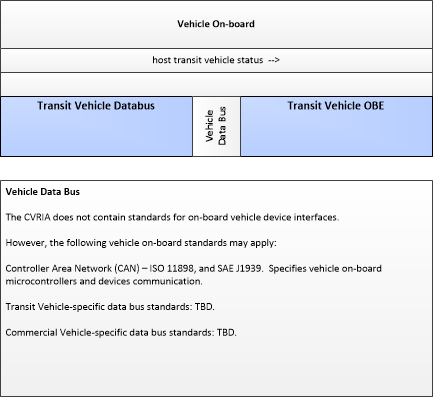Link Type: Vehicle On-Board
Transit Vehicle Databus --> Transit Vehicle OBE:
host transit vehicle status
Definitions
host transit vehicle status (Information Flow): Information provided to the Connected Vehicle on-board equipment from other systems on the Transit Vehicle Platform.
Transit Vehicle Databus (Source Physical Object): The 'Transit Vehicle Databus' represents the vehicle databus that interfaces with on-board equipment on a transit vehicle. It is a specialized and extended form of the Vehicle Databus that is subject to different vehicle databus standards and hosts a broad range of components that are unique to a transit vehicle including the farebox and associated electronics, passenger counters, and transit security systems. As a specialized form of the Vehicle Databus, it also provides access to the general-purpose sensors (e.g., radars, cameras), GPS, drive train monitoring and control systems, and vehicle safety features that support connected vehicle applications. The Transit Vehicle may represent a bus, paratransit vehicle, light rail vehicle, or other vehicle designed to carry passengers. In CVRIA, the 'Transit Vehicle Databus' is used to represent the onboard interactions between the Transit Vehicle OBE and the other systems included in a host transit vehicle.
Transit Vehicle OBE (Destination Physical Object): The Transit Vehicle On-Board equipment (OBE) resides in a transit vehicle and provides the sensory, processing, storage, and communications functions necessary to support safe and efficient movement of passengers. The types of transit vehicles containing this physical object include buses, paratransit vehicles, light rail vehicles, other vehicles designed to carry passengers, and supervisory vehicles. It collects ridership levels and supports electronic fare collection. It supports a traffic signal prioritization function that communicates with the roadside physical object to improve on-schedule performance. Automated vehicle location enhances the information available to the transit operator enabling more efficient operations. On-board sensors support transit vehicle maintenance. The physical object supports on-board security and safety monitoring. This monitoring includes transit user or vehicle operator activated alarms (silent or audible), as well as surveillance and sensor equipment. The surveillance equipment includes video (e.g. CCTV cameras), audio systems and/or event recorder systems. It also furnishes travelers with real-time travel information, continuously updated schedules, transfer options, routes, and fares. In CVRIA, a separate 'Vehicle OBE' physical object supports the general V2V and V2I safety applications and other applications that apply to all vehicles, including transit vehicles. The Transit Vehicle OBE supplements these general capabilities with capabilities that are specific to transit vehicles.
Included In
This Information Flow is in the following Applications:
- Dynamic Transit Operations
- Eco-Transit Signal Priority
- Intermittent Bus Lanes
- Transit Connection Protection
- Transit Pedestrian Indication
- Transit Signal Priority
- Transit Stop Request
- Transit Vehicle at Station/Stop Warnings
- Vehicle Turning Right in Front of a Transit Vehicle
This Information Flow is in the following Application Objects:
- Transit Vehicle Emissions Monitoring
- Transit Vehicle On-Board Connection Protection
- Transit Vehicle On-Board Paratransit Operations
- Transit Vehicle On-Board Trip Monitoring
- Transit Vehicle Passenger Counting
- Transit Vehicle Schedule Management
- Transit Vehicle Signal Priority
- Transit Vehicle V2V Safety
Communication Diagrams
The communication diagram(s) can be viewed in SVG or PNG format and the current format is SVG. Switch to PNG format.
Characteristics
Architectural:
| None defined |
Security
This information flow triple is in the following applications with the following security levels.
| Information Flow Security | |||||
|---|---|---|---|---|---|
| Application | Confidentiality | Integrity | Availability | ||
| Basis | Basis | Basis | |||
| Transit Signal Priority | Moderate | Moderate | Moderate | ||
| This can include some sensitive data. However, other data, such as vehicle location and motion will then be broadcast. There also may be proprietary information included in this. | This is used later on to determine whether a vehicle should request priority at an intersection. If this information is incorrect the vehicle may make false requests. All other flows that use the data from this flow have a MEDIUM integrity requirement, therefore, this must also have a MEDIUM integrity requirement. | This information would need to be available immediately for the application to work. | |||
